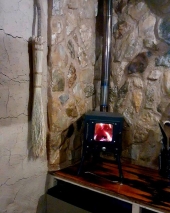


Josh Hoffman wrote:Sherry,
Great idea on the little stove. How many sqft are you able to heat with it?
We have one we use for hot tent camping and I use it to heat a portion of the barn.

Stephen B. Thomas wrote:Looks good, Sherry!
Question for you about your cob composition... How much straw would you say is mixed into your cob, compared to sand and clay?

thomas rubino wrote:Very nice looking, Sherry!
That looks like a good spot to build a 4 or5" mini batchbox masonry heater!


Riona Abhainn wrote:And this is why we couldn't have gumbo for Thanksgiving, because there wasn't any of this harvested/rendered yet for the year, and to buy it online would be crazy expensive (no my friend refuses to make gumbo without sassafras, won't touch that premade gumbo file stuff. She's waiting for her auntie to send some up here from GA in springtime, and then we can make gumbo for some other meal together. Thanks for teaching me why sassafras is so hard to come by.



William Bronson wrote:What a wonderful project!
Can you describe the details of the living roof!